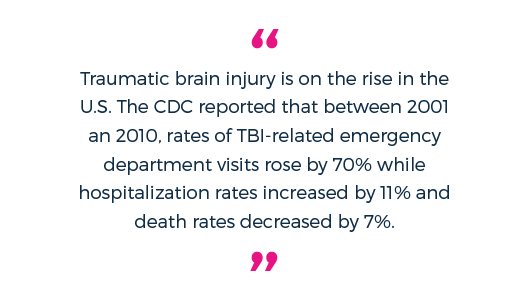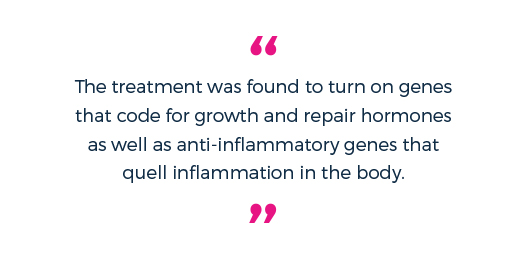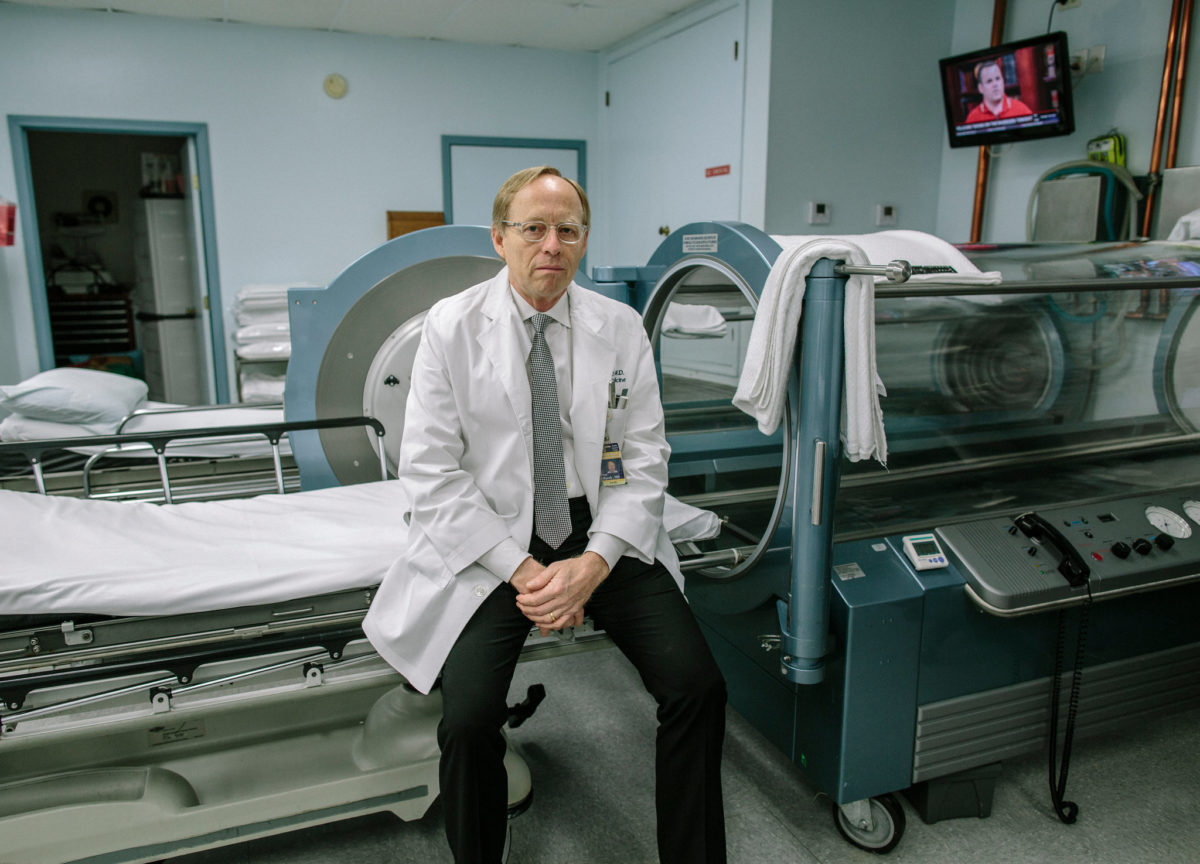Traumatic brain injury is on the rise in the U.S. The CDC reported that between 2001 and 2010, rates of TBI-related emergency department visits rose by 70 percent while hospitalization rates increased by 11 percent and death rates decreased by 7 percent.
For a long time, treatments for traumatic brain injury (TBI) have been nonexistent, and people experiencing TBI have had to deal with varying levels of physical, mental, and emotional disability because of it.
However, new research has confirmed previous theories that hyperbaric oxygen therapy (HBOT) can be an effective treatment for TBI—and now possibly even post-traumatic stress disorder (PTSD). This research, conducted by Dr. Paul Harch, a New Orleans-based hyperbaric medicine physician and researcher, could have significant implications for modern TBI and PTSD treatments.
 What is traumatic brain injury?
What is traumatic brain injury?
Traumatic brain injury (TBI) is defined by the Centers for Disease Control and Prevention as any “bump, blow or jolt to the head or a penetrating head injury that disrupts the normal function of the brain.” This trauma causes damage to the white matter, the tracts for which snap and cause loss of electrical transmission.
This damage, says Dr. Harch, is “like lowering bandwidth.” Processing speed slows down, which means people are slower at thinking, have trouble multi-tasking and often can’t be in high sensory stimulation environments. The brain can form new pathways, which enables many people with TBI to adapt rather than succumb to severe, debilitating neurological issues.
However, instead of forming a complete pathway, the brain extends the existing damaged pathways to try to maintain or replace the connections that are lost. Under stressed conditions, such as low oxygen, high altitude or sleep deprivation, the effects of the old injury can return.
Patients most commonly report headaches as a symptom, which has been identified as likely being due to injury to the meninges, where sensation occurs. Other common symptoms include fatigue, dizziness, attention and concentration difficulties, short-term memory loss, sleep disruption, irritability, mood swings, depression, and anxiety, among others.
Not all blows to the head cause TBI. When they do, they can range from mild, with just a momentary change in consciousness or mental status, to severe, which can cause a longer period of unconsciousness or amnesia after the incident, the CDC reports. Regardless of severity, all TBI cases can have varying effects on the brain.
According to the CDC, the leading cause of TBI is falls, which accounted for 40% of all TBI-related emergency department visits, hospitalizations or deaths in the U.S. from 2006-2010. Falls were a particularly high cause of brain trauma for children aged 0 to 14 (55 percent) and adults aged 65 and older (81%). Other causes include blunt trauma, such as being hit by an object, motor vehicle crashes, assaults, or essentially any incident that rattles the brain around in the skull.
The Link Between TBI and PTSD
TBI has been potentially linked to PTSD as well, so if a treatment for TBI can be found, symptoms of PTSD may also be ameliorated, particularly if the two causalities were concurrent. While PTSD can occur without a blow to the head, they can be conjoined in one brain-injuring incident.
While the two conditions may seem to symptomatically overlap, they actually may not. TBI is a physical injury to the brain with a constellation of symptoms, and the other is a psychiatric condition with its own different set of symptoms.
However, the longer someone has PTSD, sleep deprivation, a consistent elaboration of stress hormones, and other strains on the brain can eventually cause physical damage to the brain. In a similar light, having an injury to the brain may possibly injure centers of the brain that make a person more susceptible to developing PTSD. In these cases, the two conditions may begin to overlap.
Dr. Harch treated one patient with severe PTSD symptoms with HBOT, and after a couple dozen treatments, the patient returned saying that his PTSD symptoms
were gone. This has led Dr. Harch to believe that HBOT may be interrupting the circulating loop of electrical activity involved with PTSD. Treat the TBI, and PTSD may be treated along with it.
How Hyperbaric Oxygen
Affects the Brain HBOT involves placing a patient in a total body chamber and having him inhale 100 percent oxygen for a period of time while atmospheric pressure is increased and controlled by a physician. In doing so, this therapy stimulates new tissue to form.
Physicians most commonly use this treatment for severe wounds and diving accidents, but research from the past few decades has shown that hyperbaric oxygen may have more healing power for the brain than previously thought.
 Dr. Harch, who has conducted extensive research with HBOT over the past several decades, says that to stimulate new tissue, a treatment must stimulate DNA and cause the nucleus of the cell to divide. Thus, hyperbaric oxygen acts as a DNA signaling drug that increases the production of hormones that stimulate growth in different tissues.
Dr. Harch, who has conducted extensive research with HBOT over the past several decades, says that to stimulate new tissue, a treatment must stimulate DNA and cause the nucleus of the cell to divide. Thus, hyperbaric oxygen acts as a DNA signaling drug that increases the production of hormones that stimulate growth in different tissues.
One study showed that hyperbaric oxygen turned on and off specific genes that contribute to tissue growth. The treatment was found to turn on genes that code for growth and repair hormones as well as anti-inflammatory genes that quell inflammation in the body. Simultaneously, the treatment suppresses and turns off pro-inflammatory genes and the genes that code for programmed cell death.
Dr. Harch thus calls HBOT “the most enduring, most panoramic, and most effective gene therapy that has ever been identified.”
Hyperbaric Research in Action
Dr. Harch’s study is comprised of two groups of patients, both of which receive oxygen treatment for the same duration of time but at different intervals. To begin, potential participants fill out consent forms and screening questionnaires wherein they must meet certain requirements and thresholds to be a part of the study.
If chosen, they go through a full structured interview, the Ohio State University TBI Identification Method, to identify incidents of TBI in the last 10 years, from which the patient is still symptomatic, and the severity of those symptoms. Dr. Harch then has a conversation about the incidents and symptoms at length to determine if the potential participant meets any exclusion criteria.
If they pass this stage, participants perform a full day of testing with a neuropsychologist followed by a review and physical with Dr. Harch as well as screening for pregnancy and drug and alcohol abuse. From there, a computer randomizes the participants into one of two groups.
If the participant is in the control group, he returns home for eight weeks and lives as usual without starting any new medications or therapies. At eight weeks, he returns and does a repeat battery of testing and then starts HBOT once a day, five days a week, for eight weeks. After the 40 treatments, the participant is examined by Dr. Harch and then returns home for another eight weeks. Finally, the participant returns once more for cognitive testing and a visit with Dr. Harch, and then the participant has completed the study.
The other group also begins with full testing with the neuropsychologist and Dr. Harch, but instead of going home for eight weeks, the participant starts HBOT right away, the same eight-week treatment as the control group. After the eight weeks, the participant returns home for eight weeks, returns for follow-up testing, and then is done with the study.
No one in the study is given a placebo or fake treatment, which some have contested as being a kink in the research protocol. However, Dr. Harch says that a placebo for HBOT is currently unknown, as a physician has not been able to pretend to give a patient pressurized oxygen without actually doing so without the patient knowing. Dr. Harch finds an argument for any placebo effect to be highly unlikely.
After gathering all of the screening and cognitive test results, Dr. Harch statistically compares a participant’s status and levels of symptoms, IQ, etc. from the beginning of the study to immediately after HBOT. He then again statistically analyzes symptom results from the end of treatment to after the eight weeks the participant returned home to determine if the changes were maintained once treatment was completed.
The primary comparison being made is the results of no treatment versus treatment.
The goal is to see whether the HBOT has the same result on both groups as well as to assess the permanence of HBOT treatment and whether the results dissipate over time.
What The Research Found
Dr. Harch has seen significant changes as a result of the HBOT . The average change in participants’ IQ was 14 points. On average, participants improved a full standard deviation in delayed memory and two-thirds of a standard deviation in working memory and attention.
Eight of the 13 cognitive tests had extremely strong statistically significant changes, and all eight of the emotional measures, such as effects on depression, anxiety, quality of life, and so on, had highly statistically significant improvements as well. Participants also experienced a significant reduction in suicidal ideation and were able to decrease the dosage or discontinue their psychoactive medication.
Dr. Harch also compared the participants’ brain blood flow (SPECT) scan results to SPECT scan results from a previous LSU study on healthy, normal people. Initially, the brain-injured participants’ SPECT scans were statistically, significantly abnormal compared to the SPECT scans of those in the earlier study. However, after HBOT , the two groups became nearly indistinguishable. Brain blood flow had almost completely been normalized in a widespread manner in addition to the improvements in cognitive scores.
These results are in concordance with previous HBOT studies, and Dr. Harch feels they bear significant weight on the future of TBI medicine. He is also currently conducting another HBOT study for which he is actively seeking participants who have experienced traumatic brain injury at least six months to ten years ago (www.hbottbistudy.org).
“The research affects one of the most common conditions that we have in society,” said Dr. Harch. “TBI is one of the biggest health problems, one of the biggest drivers of healthcare costs, and one of the biggest contributors to long-term disability and unemployment, substance abuse, homelessness, even criminal activity.”
He continued, “A therapy that stops the injury process very early on if rendered soon after the TBI, or that can help long-term dysfunctional patients by helping to ameliorate their symptoms and make them more functional, could potentially have a huge impact. This just has tremendous importance and application to society. I believe it’s going to revolutionize the fields of medicine and neurology.”
Future Applications of Hyperbaric Oxygen
While HBOT has shown positive results for wound repair and now TBI and PTSD, Dr. Harch does not plan to stop there.
 In his book, The Oxygen Revolution, Dr. Harch tells the story of his mother, who developed severe dementia in her old age and was not given long to live. However, after hyperbaric oxygen treatments, many of her physical, mental, and emotional faculties improved, and her life was extended by several years.
In his book, The Oxygen Revolution, Dr. Harch tells the story of his mother, who developed severe dementia in her old age and was not given long to live. However, after hyperbaric oxygen treatments, many of her physical, mental, and emotional faculties improved, and her life was extended by several years.
Dr. Harch is driven to replicate those results in other cognitively impaired patients and is currently designing studies to research treatments for various groups, but he has still more in store for exciting potential uses for hyperbaric oxygen therapy.
“In addition, I’m going to apply this to cancer,” said Dr. Harch. “We have evidence that in conjunction with other agents that we have identified as tumoricidal, we can combine them with hyperbaric oxygen.”
Dr. Harch will discuss these treatments and more in the upcoming update to his book.
While New Orleans may not be as well known for medical research contributions as other parts of the country, Dr. Harch believes that tide may turn with the discovery of new utilities for hyperbaric oxygen therapies.
“I firmly believe this is going to lead the country and revolutionize medicine in its applications,” said Dr. Harch. “And it all started, or I should say really blossomed, right here.”
From The Healthcare Journal of New Orleans May/June 2015


